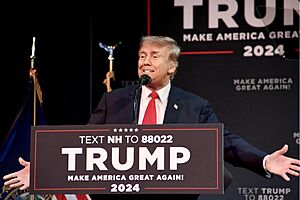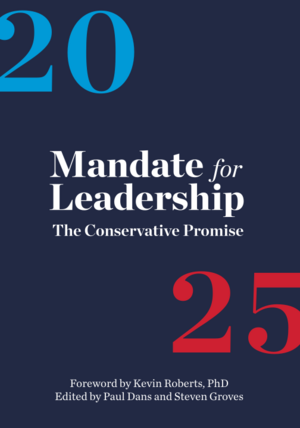Project 2025 facts for kids
 |
|
| Established | April 21, 2022 |
|---|---|
| Purpose | To create policies and find staff for a conservative presidential administration. |
| Location |
|
| Services | Creating policy plans and a list of potential government workers. |
|
Director
|
Paul Dans (until August 2024) |
|
President
|
Kevin Roberts |
| Publication | Mandate for Leadership: The Conservative Promise (2023) |
|
Parent organization
|
The Heritage Foundation |
|
Budget
|
$22 million |
Project 2025, also known as the 2025 Presidential Transition Project, is a detailed plan to change the federal government of the United States. It was created by The Heritage Foundation, a conservative think tank (a group of experts who suggest ideas about government). The project was prepared for Donald Trump's victory in the 2024 presidential election.
The main goal of Project 2025 is to give the president more control over the government. The project is based on an idea called the unitary executive theory, which says the president should have complete authority over the executive branch.
Supporters of the project say it would fix a government that they believe does not listen to the people. Critics, however, call it a plan that would give one person too much power and weaken American democracy. Some legal experts have said it could harm the rule of law and the separation of powers between the branches of government.
The plan suggests big changes, like replacing many government workers with people chosen for their loyalty to the president. It also calls for changing or getting rid of some government departments, like the Department of Education. The project also has ideas for the economy, the environment, and other areas of American life.
After winning the 2024 election, President Trump appointed several people who helped create Project 2025 to high-level positions in his new administration.
Contents
What is Project 2025?
Project 2025 was started in 2022 by The Heritage Foundation. This organization has been influential in American conservative politics for many years. The project's leader, Kevin Roberts, said its goal was to be ready for a new conservative president.
The project has four main parts:
- The Mandate for Leadership: A nearly 1,000-page book that explains all the policy ideas.
- A Personnel Database: A list of people who could be hired to work in the new government.
- Training: Online courses to teach these potential new workers about the project's goals.
- A 180-Day Playbook: A step-by-step guide for the president's first six months in office.
While the Trump campaign said that Project 2025 was not its official plan, its goals were very similar to Trump's own platform, known as Agenda 47.
Main Goals of the Project
The writers of Project 2025 outlined four main goals in their "Mandate for Leadership" book:
- Make the family the center of American life.
- Reduce the size and power of many government agencies, which they call the "administrative state."
- Defend the nation's borders and sovereignty.
- Protect what they describe as God-given individual rights to live freely.
The project's leaders believe that many government agencies have become too powerful and have pushed ideas that they disagree with. They wanted to prepare a team of conservatives to be ready to change this on the first day of a new presidency.
Major Policy Ideas
More Power for the President
A central idea of Project 2025 is to increase the president's power. The plan argues that independent government agencies, like the Department of Justice (DOJ) and the FBI, should be under the president's direct control.
This would mean the president could more easily direct these agencies to follow his policy goals. Critics worry this could remove important checks and balances that prevent a president from having too much power.
Changing Government Staff

Project 2025 proposes a plan to replace thousands of federal government workers. Normally, these workers are part of the civil service, meaning they are hired based on their skills and are not supposed to be political.
The project suggests reclassifying up to 50,000 of these workers as political appointees using a rule called Schedule F. This would make it easier for the president to fire them and hire people who are more loyal to his agenda. Supporters say this is needed to make the government follow the will of the voters. Critics argue it could lead to a less experienced and more political government workforce.
The Economy and Taxes
The project includes several ideas for the economy. It suggests simplifying the tax code, possibly by creating a flat tax where most people pay the same tax rate. It also aims to lower the corporate tax rate for businesses.
Project 2025 is critical of the Federal Reserve, the central bank of the U.S. It suggests major changes to its role, including focusing only on controlling inflation instead of also trying to achieve full employment.
Environment and Energy
The plan calls for major changes to environmental policy. It proposes increasing the production of fossil fuels like oil, gas, and coal. It also suggests repealing many regulations designed to fight climate change.
Agencies like the Environmental Protection Agency (EPA) would be reduced in size and power. The project also suggests stopping government efforts to switch to renewable energy sources like solar and wind power.
Education
A key goal of Project 2025 is to reduce the federal government's role in education. The plan proposes closing the Department of Education entirely.
It suggests that funding and control over education should be given to states and local communities. The project also supports school choice, which allows parents to use public funds to send their children to private or religious schools.
Immigration
Project 2025 calls for much stricter immigration enforcement. The plan includes ideas for large-scale deportation of immigrants who are in the country without legal permission.
It also suggests finishing the wall on the U.S.-Mexico border and using the U.S. military to help with domestic law enforcement at the border.
Social Policies
The project aims to change many government policies related to social issues. It proposes removing programs focused on diversity, equity, and inclusion (DEI) from all federal agencies.
The plan also promotes what it calls a "biblically based" definition of marriage and family. It suggests removing government protections related to gender identity.
Implementation and Reactions
Putting the Plan into Action
After Donald Trump won the 2024 election, his administration began to implement many ideas from Project 2025. In the first months of 2025, President Trump signed several executive orders that closely matched the project's goals.
For example, he signed an order to reinstate Schedule F, allowing for the potential replacement of many federal workers. He also nominated many of Project 2025's authors and contributors to lead key government agencies, including Russell Vought to direct the Office of Management and Budget. Other executive orders began to roll back environmental regulations and change education policies, reflecting the "Mandate for Leadership."
How People Reacted
Project 2025 has caused a lot of debate.
- Supporters say the plan is a necessary roadmap to fix a government they see as inefficient and out of control. They believe it will restore power to the president who was elected by the people.
- Critics, including the Biden-Harris campaign in 2024, called the plan a threat to American democracy. They argued that it would lead to an abuse of power, weaken civil rights, and damage the country's democratic institutions. Some conservatives also criticized the plan, especially its ideas on foreign policy and the environment.
See also
In Spanish: Proyecto 2025 para niños



